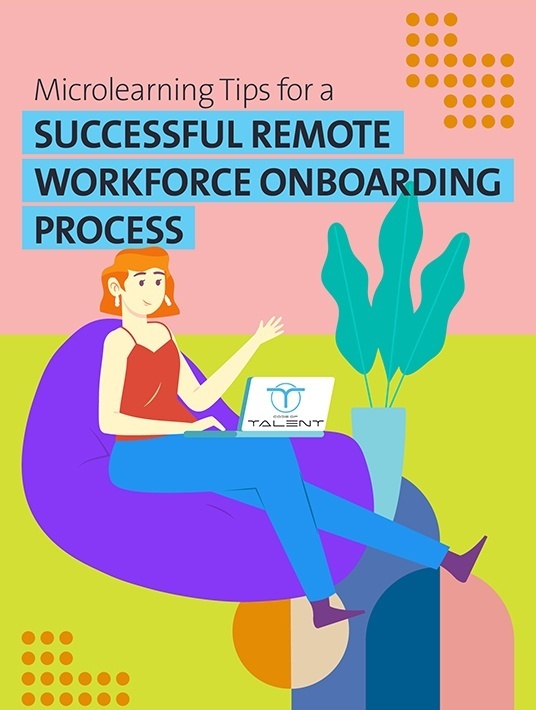Succeed In Remote Onboarding Training With Microlearning
With the proliferation of mobile devices and ultra-speed internet, microlearning and microlearning systems have increased in popularity. As it has been proven to save time and money, microlearning is being hailed by many trainers as a life-saver. Every successful business requires staff with the right abilities. And in today's dynamic business environments, being able to offer these skills to the workers in the right way is more critical than ever. Despite this significant and growing need for new skills, internal training systems often do not meet most workers' expectations. So, how are you going to master remote onboarding training?

50% of the employees jointly surveyed by LinkedIn and Capgemini—a French multinational consulting firm—saw their company’s training programs as ineffective, pointless, and dull [1].
Additionally, Deloitte reports that the average worker only has time to dedicate 1 percent of their workweek to professional growth. This converts into just 4.8 minutes a day for those who do a 40-hour per week shift [1].
With the skills gap estimated to cost the U.S economy $2.5 trillion over the next decade [1], it has become more important than ever to deliver the right training—one that makes a difference in their job and professional interactions—to employees, and it needs to start with the remote onboarding training process.
The good news is that a solution is already available to bridge the skills gap not just for the future but also for current organizational needs. Microlearning is what I am referring to. The following is a brief introduction to microlearning followed by its benefits for learners during an onboarding process such as remote onboarding training.
Microlearning Explained: An Introduction To Microlearning For Remote Onboarding Training
If you have been searching for an effective way to onboard new remote workers, then your search ends here.
This is because microlearning can be customized to personalize training for your remote workforce; it features compact and small learning modules designed to accomplish a specific learning objective. The learning modules or lessons are generally three to six minutes long and feature-rich content, such as games, quizzes, and videos. In other words, it offers an interactive learning experience.
While microlearning can be used to impart training to new on-site employees, it has been designed for online learning, which makes it ideal for onboarding remote workers. Microlearning platforms make remote onboarding training easier and more effective by providing the versatility and simplicity desired by today’s time-strapped learners.
From technical skills training to leadership and project management training to an organization and industry-specific QA training to soft skills training, microlearning modules can be utilized for a wide range of learning objectives. And all of this has been proven to have a positive effect.
A Gallup survey finds that microlearning increases engagement by 50% while improving the retention of knowledge/skills and reducing operational costs by half [2]. Considering this, it does not come as a surprise that 8 out of 10 L&D professionals opt for microlearning as their preferred training method for their learners [3].
By now, there should be no doubt left in your mind that bite-size learning—microlearning—is the way forward when it comes to onboarding new employees into the company and their jobs, especially when the new employees happen to be remote workers.
The proliferation of mobile devices and constant pressure to onboard new employees quickly and efficiently should make microlearning an automatic choice for trainers. However, there are some organizations and trainers that prefer to sit on the fence and wait for someone to lure them into making the jump. If you are amongst them, then the benefits of microlearning for learners detailed below might convince to make the shift to the platform.
The Benefits Of Microlearning For Learners
Delve deeper and you will begin to notice that microlearning is not just about size; its advantages go far beyond ease of use. Content is systematically deconstructed and catalogued into individually-standing learning areas. It is about ‘being specific’ rather than ‘dumbing it down.’
Consider microlearning experiences as train stations that are interlinked and enable the student to double back. Additionally, organizations are not 'restricted' to a fixed route. Hotspots that require extra focus can be found by evaluating interaction and learning metrics, and organizations can detour to a revised path.
To put it simply, microlearning is an instructional method that offers the right amount of data to help learners achieve clear, actionable goals. It is an instructional technique that offers two to five minutes of information chunks that helps learners reach a clear, actionable goal or result.
With millennials and those younger anticipated to constitute 50 percent of the U.S. population by 2030 [4], there is an increased focus on microlearning. With average attention periods reduced to 12 seconds, it is no ordinary job to engage the millennial workforce [5].
Because millennials hold different views from the employees of previous generations, it is crucial that remote onboarding training is updated to win the attention of millennials through engaging content. Microlearning fits that bill.
Bit-sized learning has allowed mobile users to complete online training 45% faster than the training provided at various non-office sites. Additionally, employees—especially the remote workforce—can now complete the remote onboarding training at a time and place of their convenience. There are many other reasons microlearning makes sense for these learners. The following is the complete list of benefits that can be obtained by using microlearning to conduct remote onboarding training.
1. A Catered Approach To Learning
Learners have the freedom to concentrate on lessons that are the most important to them because of the flexible nature of microlearning courses. Every lesson is aimed at achieving one or a few learning objectives. This offers the greater capability for course designers to produce various types of content (e.g., quizzes, videos, games, activity files, and overview sheets) for every lesson. This diversity of content helps learners to take data in a manner that best suits them.
2. Just-In-Time Learning
- Have you ever looked up a statistic to conclude a discussion at the dinner table?
- Have you ever searched reviews on Yelp to choose the best dishes in an eatery to order?
- Have you ever searched Google for a concept’s definition that you needed urgently?
You have participated in some sort of Just-In-Time learning if you answered yes to any of the above.
Microlearning takes this type of learning to the workplace. Here, microlearning provides learners with the capability to learn skills and come up with solutions as soon as there is a need for them. For employees who need knowledge accessible on the spot, this type of learning is especially useful for remote onboarding training.
Learning that the first use of "orange" was to identify the fruit and not the color is the knowledge that would be useless until the topic becomes part of a dinner table discussion. This fact would definitely be forgotten if you heard it a month prior to the discussion. This is why learning ‘Just-In-Time’ or acquiring knowledge/information only when it is needed is so crucial.
3. High Retention Rates
We forget 80% of what we've learned in thirty days, according to 'Forgetting Curve' by Hermann Ebbinghaus [6]. This implies that conventional modes of learning (e.g., classroom training one-off workshops) may restrict ROI, in addition to being time-consuming for learners and expensive for companies. In order to prolong the lifetime of knowledge, microlearning can be used as standalone training or formal learning that supplements another training activity.
For three main factors, microlearning facilitates knowledge retention: short learning modules, courses available on-demand, and learning built to be actionable. Unlike classroom-based instruction, microlearning is accessible online to learners at a time and place of their convenience. This implies that the needed knowledge can be accessed at the point of need, which makes it more likely to stick in the remote onboarding training process.
Our brains aren't designed to stay focused for large spells. Microlearning facilitates our brain with modules that are purposefully short to fit our recognition memory. This helps to avoid cognitive fatigue, which is particularly beneficial when learning about complex subjects. Finally, to meet a highly specified learning outcome, bite-sized lessons are meticulously planned. This makes every lesson highly actionable.
4. Mobile Learning
As previously mentioned, microlearning modules are accessible to learners at a time and place of their convenience; they can begin a module at a co-working space, access it on their smartphone while traveling, and resume learning at home on a device of their choice. This versatility makes learning easier for the remote onboarding training participants who are extremely bad at managing their time.
5. Self-Paced Learning
Think back to that time when you last enrolled in a course offered in groups. There were undoubtedly some topics that you easily understood and some that you might have understood better if you had more time. Classroom courses are built to fit the room's average learning speed. Quick learners in these learning environments can often lose interest in this topic, while slower learners can get caught trying to catch-up. This issue is eliminated by microlearning because learners are able to move at their own speed through the content.
6. More Engaging Learning Content For Remote Onboarding Training
Every micro lesson is designed to accomplish a specific learning objective. This provides the opportunity for course designers to use more immersive knowledge transfer tools, such as games, storytelling, and videos. In order to make learning more likely to stick, gamification techniques can be integrated into microlearning, where participants of remote onboarding training can gain rewards or experience points.
The above list is not exhaustive and there are many more benefits of using microlearning to provide remote onboarding training. However, looking at the above benefits, we can conclude that microlearning not only meets the needs of the future by reaching learners where they are today, but it also provides a multitude of benefits that makes learning more engaging, personal, and long-lasting for them.
If you are wondering about the benefits microlearning has to offer to your remote workforce onboarding process, download the eBook Microlearning Tips For A Successful Remote Workforce Onboarding Process. Discover the best microlearning tips that will help you succeed in your remote workforce onboarding process stress-free. Join our webinar and learn which microlearning platform features will boost your employee onboarding process!
References:
[1] The Digital Talent Gap
[2] Top LMS Features To Drive Employee Engagement
[3] RLI survey: Bite-size learning is hot at ASTD Conference, but execution is lagging back on the home front
[4] More than 50% of the US population is now under the age of 40
[5] You Now Have a Shorter Attention Span Than a Goldfish
[6] Replication and Analysis of Ebbinghaus’ Forgetting Curve









